Establishment of Silane/GO Multistage Hybrid Interface Layer to Improve Interfacial and Mechanical Properties of Carbon Fiber Reinforced Poly (phthalazinone ether ketone) Thermoplastic Composites
Abstract
:1. Introduction
2. Experiment
2.1. Materials
2.2. Preparation of KHN+ Silane Functionalized CF
2.3. Preparation GO/CF Muti-Scale Reinforcements
2.4. Preparation of CF/PPEK Composites
2.5. Characterization Methods
3. Results and Discussion
3.1. Surface Structures and Chemical Elements of CF
3.2. Surface Morphology of CF
3.3. Surface Free Energy Analysis and Wettability of CFs
3.4. Interfacial Property Testing of Composites
3.5. Fractured Surface Morphology of Composites
4. Conclusions
Supplementary Materials
Author Contributions
Funding
Institutional Review Board Statement
Informed Consent Statement
Data Availability Statement
Acknowledgments
Conflicts of Interest
References
- Li, N.; Yang, X.; Bao, F.; Pan, Y.; Wang, C.; Chen, B.; Zong, L.; Liu, C.; Wang, J.; Jian, X. Improved Mechanical Properties of Copoly(Phthalazinone Ether Sulphone)s Composites Reinforced by Multiscale Carbon Fibre/Graphene Oxide Reinforcements: A Step Closer to Industrial Production. Polymers 2019, 11, 237. [Google Scholar] [CrossRef] [PubMed] [Green Version]
- Li, N.; Wu, Z.; Yang, X.; Wang, C.; Zong, L.; Pan, Y.; Wang, J.; Jian, X. One-pot strategy for covalent construction of POSS-modified silane layer on carbon fiber to enhance interfacial properties and anti-hydrothermal aging behaviors of PPBES composites. J. Mater. Sci. 2018, 53, 16303–16317. [Google Scholar] [CrossRef]
- Dong, J.; Ma, X.; Xiao, L.; Ao, Y. Carbon fiber composite of phenolic resin matrix: Study on preparation and frictional wear performance. New Chem. Mater. 2017, 45, 116–118. [Google Scholar]
- Zeng, L.; Liu, X.; Chen, X.; Soutis, C. Pi-Pi interaction between carbon fibre and epoxy resin for interface improvement in composites. Compos. Part B Eng. 2021, 220, 108983. [Google Scholar] [CrossRef]
- Thomas, A.J.; Kim, J.J.; Tallman, T.N.; Bakis, C.E. Damage detection in self-sensing composite tubes via electrical impedance tomography. Compos. Part B Eng. 2019, 177, 107276. [Google Scholar] [CrossRef]
- Liu, Y.-T.; Song, H.-Y.; Yao, T.-T.; Zhang, W.-S.; Zhu, H.; Wu, G.-P. Effects of carbon nanotube length on interfacial properties of carbon fiber reinforced thermoplastic composites. J. Mater. Sci. 2020, 55, 15467–15480. [Google Scholar] [CrossRef]
- Kwon, Y.J.; Kim, Y.; Jeon, H.; Cho, S.; Lee, W.; Lee, J.U. Graphene/carbon nanotube hybrid as a multi-functional interfacial reinforcement for carbon fiber-reinforced composites. Compos. Part B Eng. 2017, 122, 23–30. [Google Scholar] [CrossRef]
- Zhang, T.; Cheng, Q.; Xu, Z.; Jiang, B.; Wang, C.; Huang, Y. Improved interfacial property of carbon fiber composites with carbon nanotube and graphene oxide as multi-scale synergetic reinforcements. Compos. Part A Appl. Sci. Manuf. 2019, 125, 105573. [Google Scholar] [CrossRef]
- Xiong, L.; Zhan, F.; Liang, H.; Chen, L.; Lan, D. Chemical grafting of nano-TiO2 onto carbon fiber via thiol-ene click chemistry and its effect on the interfacial and mechanical properties of carbon fiber/epoxy composites. J. Mater. Sci. 2018, 53, 2594–2603. [Google Scholar] [CrossRef]
- Wang, F.; Cai, X. Improvement of mechanical properties and thermal conductivity of carbon fiber laminated composites through depositing graphene nanoplatelets on fibers. J. Mater. Sci. 2019, 54, 3847–3862. [Google Scholar] [CrossRef]
- Yan, F.; Liu, L.; Li, M.; Zhang, M.; Xiao, L.; Ao, Y. Preparation of carbon nanotube/copper/carbon fiber hierarchical composites by electrophoretic deposition for enhanced thermal conductivity and interfacial properties. J. Mater. Sci. 2018, 53, 8108–8119. [Google Scholar] [CrossRef]
- Lee, E.-S.; Lee, C.-H.; Chun, Y.-S.; Han, C.-J.; Lim, D.-S. Effect of hydrogen plasma-mediated surface modification of carbon fibers on the mechanical properties of carbon-fiber-reinforced polyetherimide composites. Compos. Part B Eng. 2017, 116, 451–458. [Google Scholar] [CrossRef]
- Yim, Y.-J.; Bae, K.-M.; Park, S.-J. Influence of Oxyfluorination on Geometrical Pull-Out Behavior of Carbon-Fiber-Reinforced Epoxy Matrix Composites. Macromol. Res. 2018, 26, 794–799. [Google Scholar] [CrossRef]
- Liu, L.; Yan, F.; Li, M.; Zhang, M.; Xiao, L.; Shang, L.; Ao, Y. A novel thermoplastic sizing containing graphene oxide functionalized with structural analogs of matrix for improving interfacial adhesion of CF/PES composites. Compos. Part A Appl. Sci. Manuf. 2018, 114, 418–428. [Google Scholar] [CrossRef]
- Wang, X.; Li, C.; Chi, Y.; Piao, M.; Chu, J.; Zhang, H.; Li, Z.; Wei, W. Effect of Graphene Nanowall Size on the Interfacial Strength of Carbon Fiber Reinforced Composites. Nanomaterials 2018, 8, 414. [Google Scholar] [CrossRef] [Green Version]
- Hu, J.Q.; Li, F.; Wang, B.; Zhang, H.Q.; Ji, C.M.; Wang, S.X.; Zhou, Z.G. A two-step combination strategy for significantly enhancing the interfacial adhesion of CF/PPS composites: The liquid-phase oxidation followed by grafting of silane coupling agent. Compos. Part B Eng. 2020, 191, 12. [Google Scholar] [CrossRef]
- Yao, X.M.; Gao, X.Y.; Jiang, J.J.; Xu, C.M.; Deng, C.; Wang, J.B. Comparison of carbon nanotubes and graphene oxide coated carbon fiber for improving the interfacial properties of carbon fiber/epoxy composites. Compos. Part B Eng. 2018, 132, 170–177. [Google Scholar] [CrossRef]
- Wang, C.; Zhao, M.; Li, J.; Yu, J.; Sun, S.; Ge, S.; Guo, X.; Xie, F.; Jiang, B.; Wujcik, E.K.; et al. Silver nanoparticles/graphene oxide decorated carbon fiber synergistic reinforcement in epoxy-based composites. Polymer 2017, 131, 263–271. [Google Scholar] [CrossRef]
- Kinloch, I.A.; Suhr, J.; Lou, J.; Young, R.J.; Ajayan, P.M. Composites with carbon nanotubes and graphene: An outlook. Science 2018, 362, 547–553. [Google Scholar] [CrossRef] [Green Version]
- He, M.; Xu, P.; Zhang, Y.; Liu, K.; Yang, X. Phthalocyanine nanowires@GO/carbon fiber composites with enhanced interfacial properties and electromagnetic interference shielding performance. Chem. Eng. J. 2020, 388, 124255. [Google Scholar] [CrossRef]
- Wang, C.; Li, J.; Yu, J.; Sun, S.; Li, X.; Xie, F.; Jiang, B.; Wu, G.; Yu, F.; Huang, Y. Grafting of size-controlled graphene oxide sheets onto carbon fiber for reinforcement of carbon fiber/epoxy composite interfacial strength. Compos. Part A Appl. Sci. Manuf. 2017, 101, 511–520. [Google Scholar] [CrossRef]
- Liu, L.; Yan, F.; Li, M.; Zhang, M.J.; Xiao, L.H.; Shang, L.; Ao, Y.H. Improving interfacial properties of hierarchical reinforcement carbon fibers modified by graphene oxide with different bonding types. Compos. Part A Appl. Sci. Manuf. 2018, 107, 616–625. [Google Scholar] [CrossRef]
- Zheng, H.; Li, Q.; Yu, C.; Zhu, X.; Guo, P.; Mu, Y.; Ma, L. The direct architecture of carbon fiber-carbon nanofiber hierarchical reinforcements for superior interfacial properties of CF/epoxy composites. Polym. Adv. Technol. 2019, 30, 620–630. [Google Scholar] [CrossRef]
- Yuan, C.; Li, D.; Yuan, X.; Liu, L.; Huang, Y. Preparation of semi-aliphatic polyimide for organic-solvent-free sizing agent in CF/PEEK composites. Compos. Sci. Technol. 2021, 201, 108490. [Google Scholar] [CrossRef]
- Yuan, X.; Jiang, J.; Wei, H.; Yuan, C.; Wang, M.; Zhang, D.; Liu, L.; Huang, Y.; Gao, G.-L.; Jiang, Z. PAI/MXene sizing-based dual functional coating for carbon fiber/PEEK composite. Compos. Sci. Technol. 2021, 201, 108496. [Google Scholar] [CrossRef]
- Jiao, W.; Liu, W.; Yang, F.; Jiang, L.; Jiao, W.; Wang, R. Improving the interfacial property of carbon fiber/vinyl ester resin composite by grafting modification of sizing agent on carbon fiber surface. J. Mater. Sci. 2017, 52, 13812–13828. [Google Scholar] [CrossRef]
- Zhu, P.; Shi, J.; Bao, L. Effect of polyetherimide nanoparticle coating on the interfacial shear strength between carbon fiber and thermoplastic resins. Appl. Surf. Sci. 2020, 509, 145395. [Google Scholar] [CrossRef]
- Zhang, W.; Deng, X.; Sui, G.; Yang, X. Improving interfacial and mechanical properties of carbon nanotube-sized carbon fiber/epoxy composites. Carbon 2019, 145, 629–639. [Google Scholar] [CrossRef]
- Wang, T.; Jiao, Y.S.; Mi, Z.M.; Li, J.T.; Wang, D.R.N.; Zhao, X.G.; Zhou, H.W.; Chen, C.H. PEEK composites with polyimide sizing SCF as reinforcement: Preparation, characterization, and mechanical properties. High. Perform. Polym. 2020, 32, 383–393. [Google Scholar] [CrossRef]
- Wen, Z.; Xu, C.; Qian, X.; Zhang, Y.; Wang, X.; Song, S.; Dai, M.; Zhang, C. A two-step carbon fiber surface treatment and its effect on the interfacial properties of CF/EP composites: The electrochemical oxidation followed by grafting of silane coupling agent. Appl. Surf. Sci. 2019, 486, 546–554. [Google Scholar] [CrossRef]
- Moreno-Castilla, C. Adsorption of organic molecules from aqueous solutions on carbon materials. Carbon 2004, 42, 83–94. [Google Scholar] [CrossRef] [Green Version]
- Zhu, S.; He, S.; Gao, J.; Elwathig, A.M.H.; Ge, D.; Liu, Q.; Guo, W.; Yu, M. Polyetheretherketone Matrix Composites Based on Graphene Oxide Modified Activated Carbon Fibers. Polym. Mater. Sci. Eng. 2019, 35, 130. [Google Scholar]
- Chang, Q.; Zhao, H.; He, R. The mechanical properties of plasma-treated carbon fiber reinforced PA6 composites with CNT. Surf. Interface Anal. 2017, 49, 1244–1248. [Google Scholar] [CrossRef]
- Wu, G.; Ma, L.; Jiang, H.; Liu, L.; Huang, Y. Improving the interfacial strength of silicone resin composites by chemically grafting silica nanoparticles on carbon fiber. Compos. Sci. Technol. 2017, 153, 160–167. [Google Scholar] [CrossRef]
- Sun, J.; Zhao, F.; Yao, Y.; Jin, Z.; Liu, X.; Huang, Y. High efficient and continuous surface modification of carbon fibers with improved tensile strength and interfacial adhesion. Appl. Surf. Sci. 2017, 412, 424–435. [Google Scholar] [CrossRef]
- Wu, N.; She, X.; Yang, D.; Wu, X.; Su, F.; Chen, Y. Synthesis of network reduced graphene oxide in polystyrene matrix by a two-step reduction method for superior conductivity of the composite. J. Mater. Chem. 2012, 22, 17254–17261. [Google Scholar] [CrossRef]
- Qian, X.; Zhong, J.; Zhi, J.; Heng, F.; Wang, X.; Zhang, Y.; Song, S. Electrochemical surface modification of polyacrylonitrile-based ultrahigh modulus carbon fibers and its effect on the interfacial properties of UHMCF/EP composites. Compos. Part B Eng. 2019, 164, 476–484. [Google Scholar] [CrossRef]
- Yamauchi, S.; Kurimoto, Y. Raman spectroscopic study on pyrolyzed wood and bark of Japanese cedar: Temperature dependence of Raman parameters. J. Wood Sci. 2003, 49, 235–240. [Google Scholar] [CrossRef]
- Zhao, M.; Meng, L.; Ma, L.; Wu, G.; Wang, Y.; Xie, F.; Huang, Y. Interfacially reinforced carbon fiber/epoxy composites by grafting melamine onto carbon fibers in supercritical methanol. RSC Adv. 2016, 6, 29654–29662. [Google Scholar] [CrossRef]
- Ageorges, C.; Friedrich, K.; Ye, L. Experiments to relate carbon-fibre surface treatments to composite mechanical properties. Compos. Sci. Technol. 1999, 59, 2101–2113. [Google Scholar] [CrossRef]
- Hernandez, T.P.A.; Mills, A.R.; Nezhad, H.Y. Shear driven deformation and damage mechanisms in High-performance carbon Fibre-reinforced thermoplastic and toughened thermoset composites subjected to high strain loading. Compos. Struct. 2021, 261, 113289. [Google Scholar] [CrossRef]
- Li, N.; Zong, L.; Wu, Z.; Wang, X.; Bao, F.; Wang, J.; Jian, X. Compatibilization effect of aminated poly(phthalazinone ether ketone)s in carbon fiber-reinforced copoly(phthalazinone ether sulfone)s composites. Polym. Compos. 2018, 39, 4139–4147. [Google Scholar] [CrossRef]
- Chou, C.T.; Gaur, U.; Miller, B. Fracture mechanisms during fiber pull-out for carbon-fiber-reinforced thermosetting composites. Compos. Sci. Technol. 1993, 48, 307–316. [Google Scholar] [CrossRef]
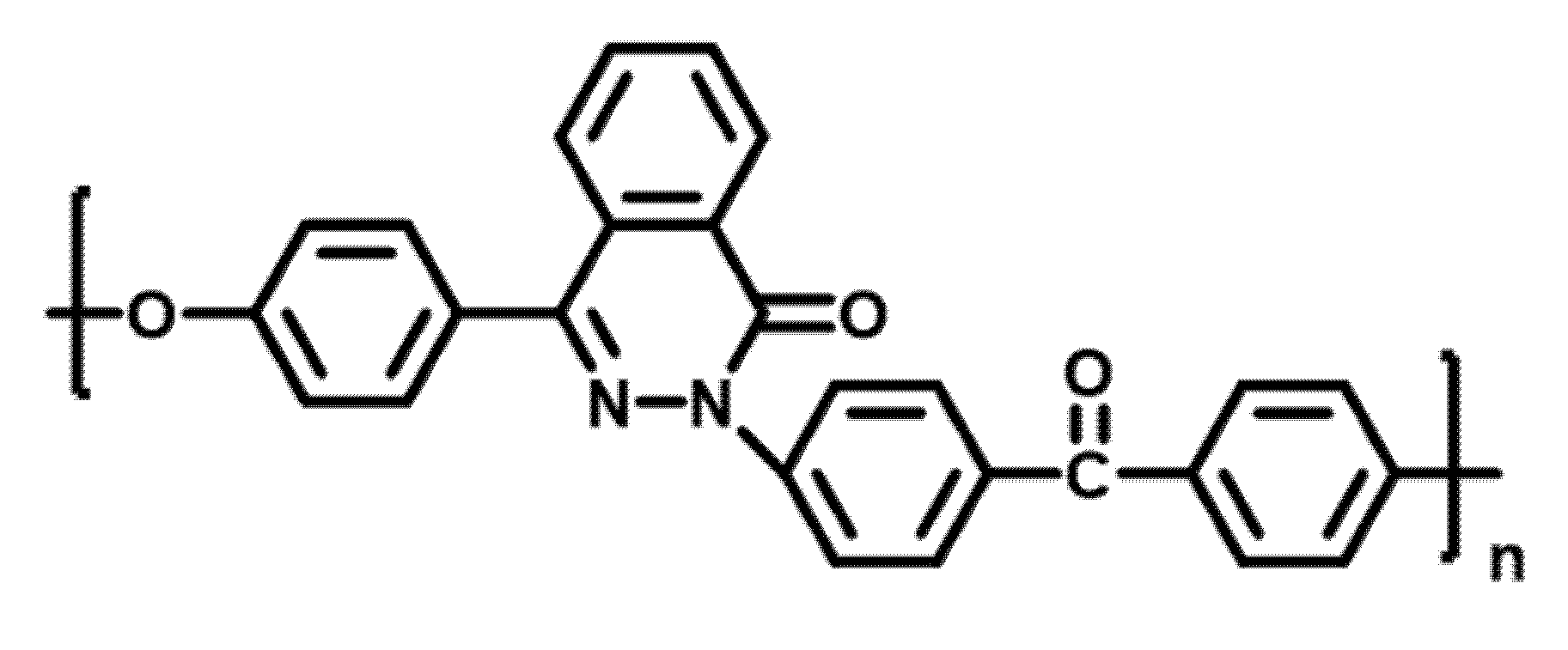
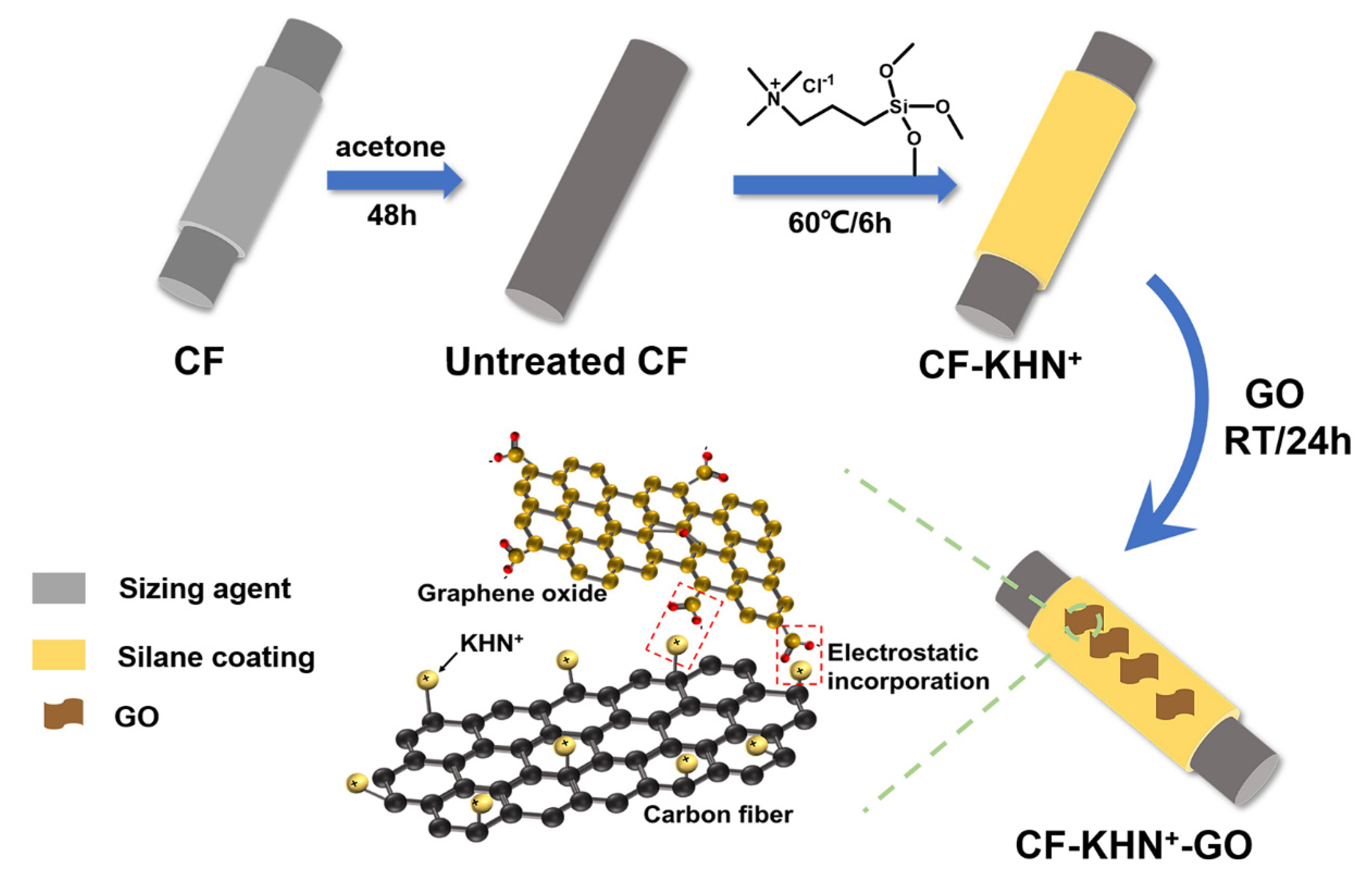
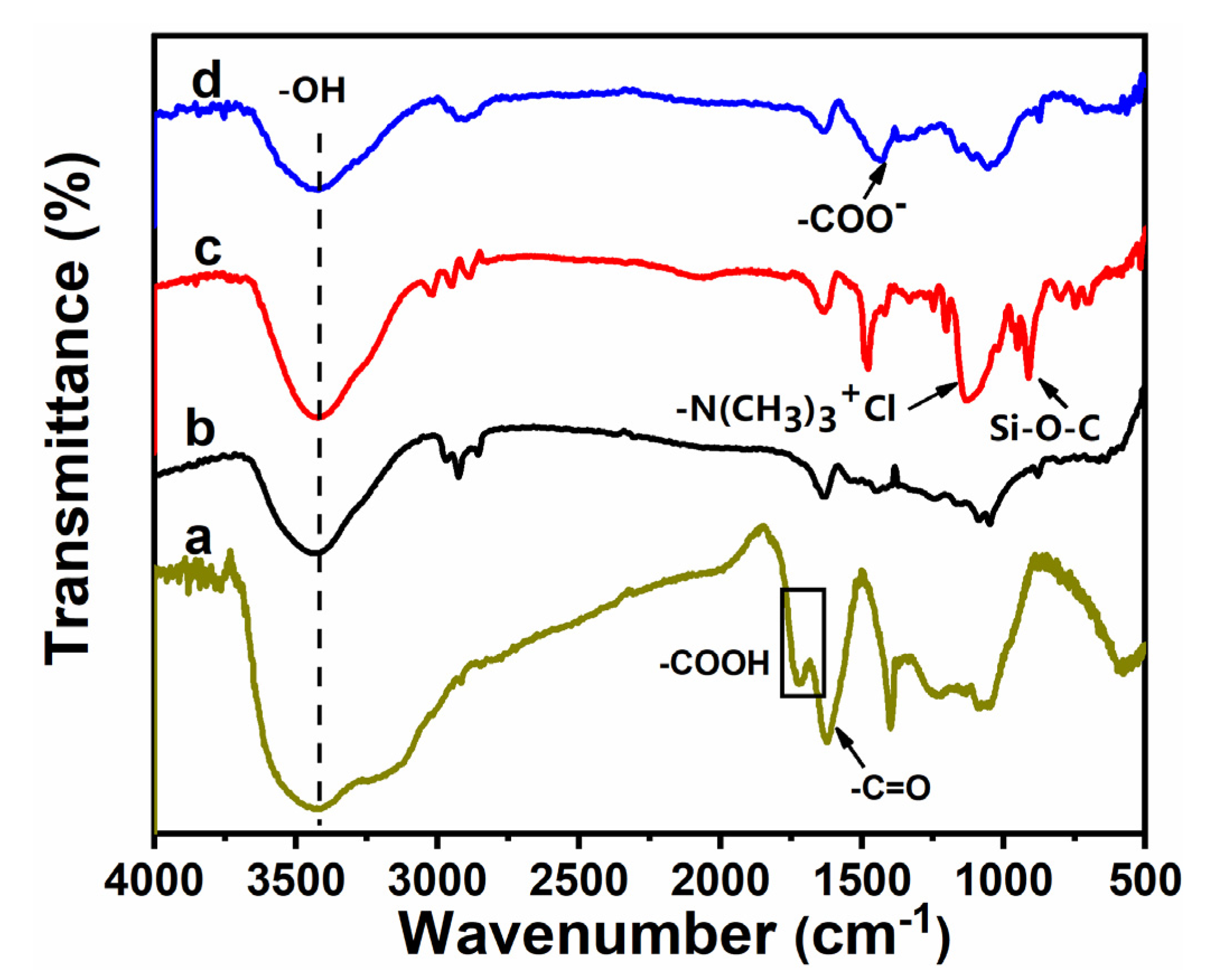

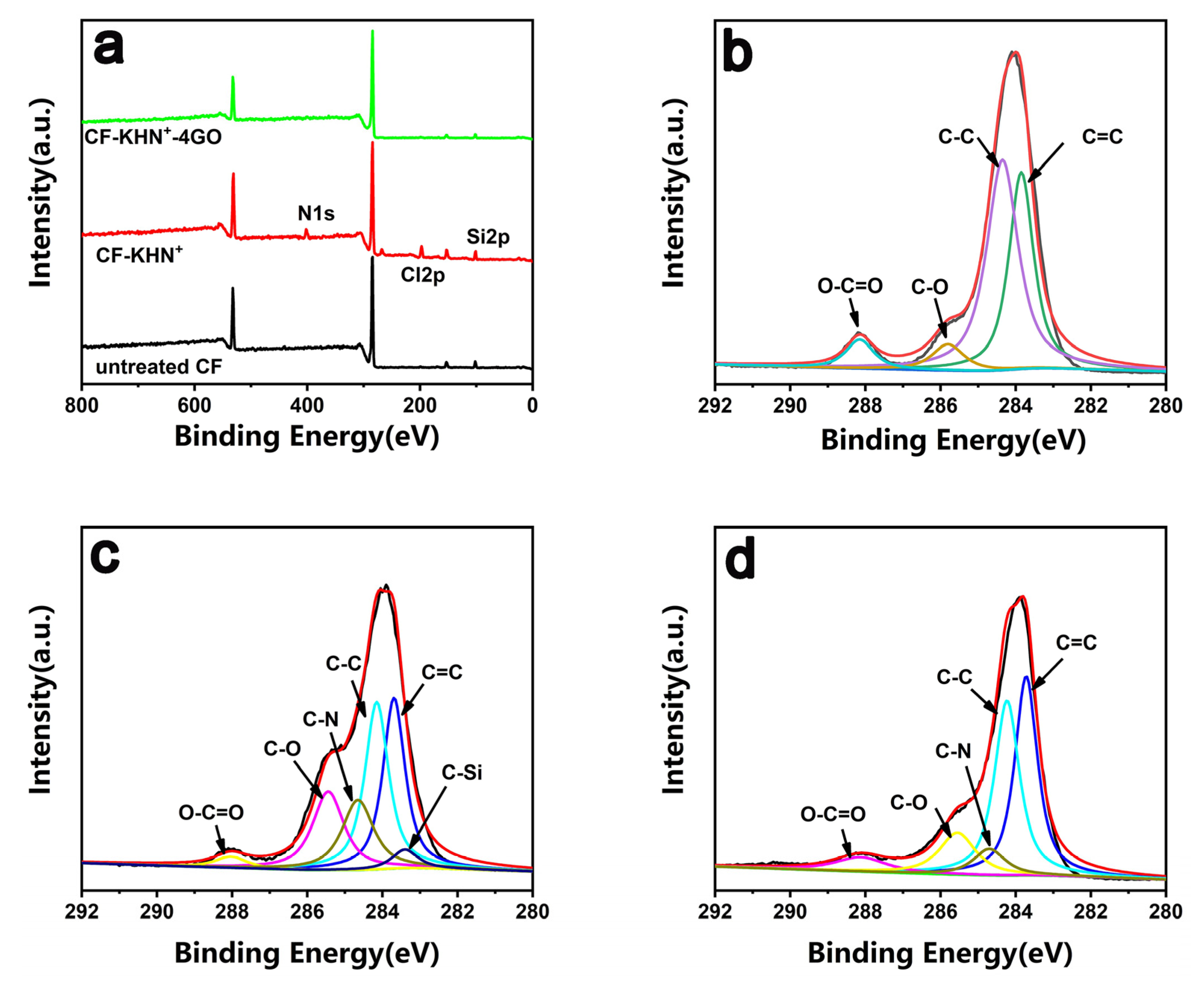
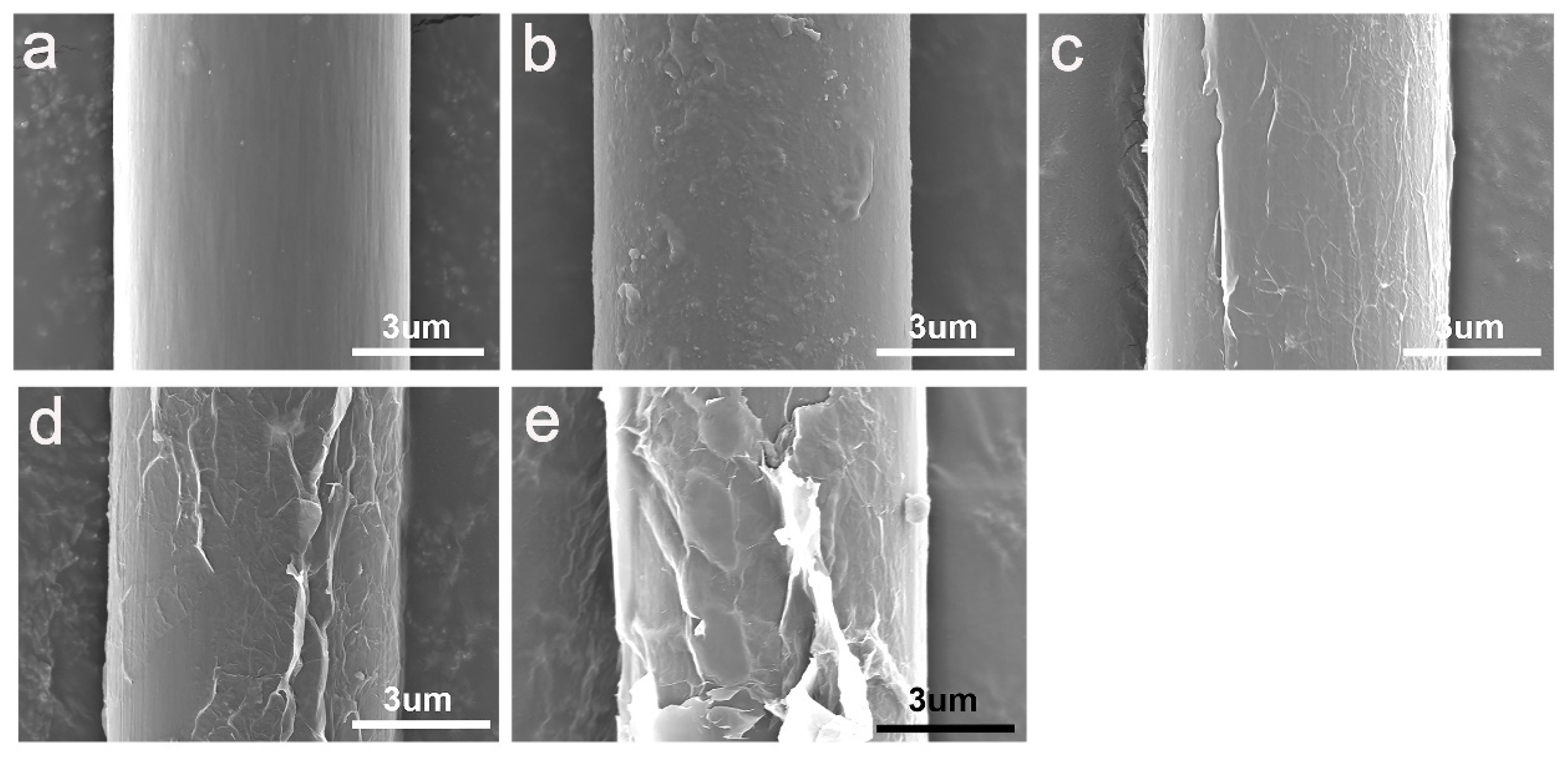
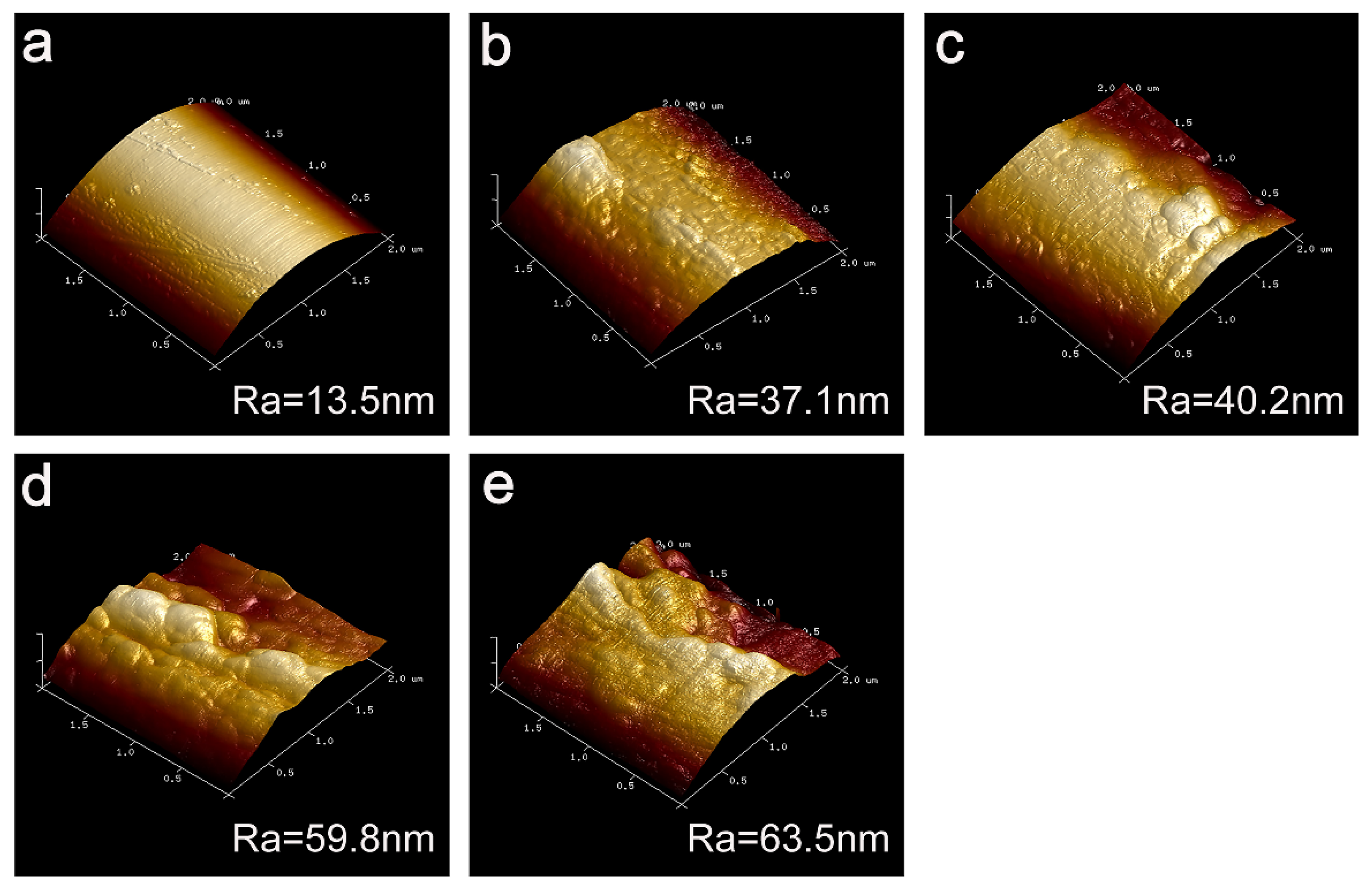


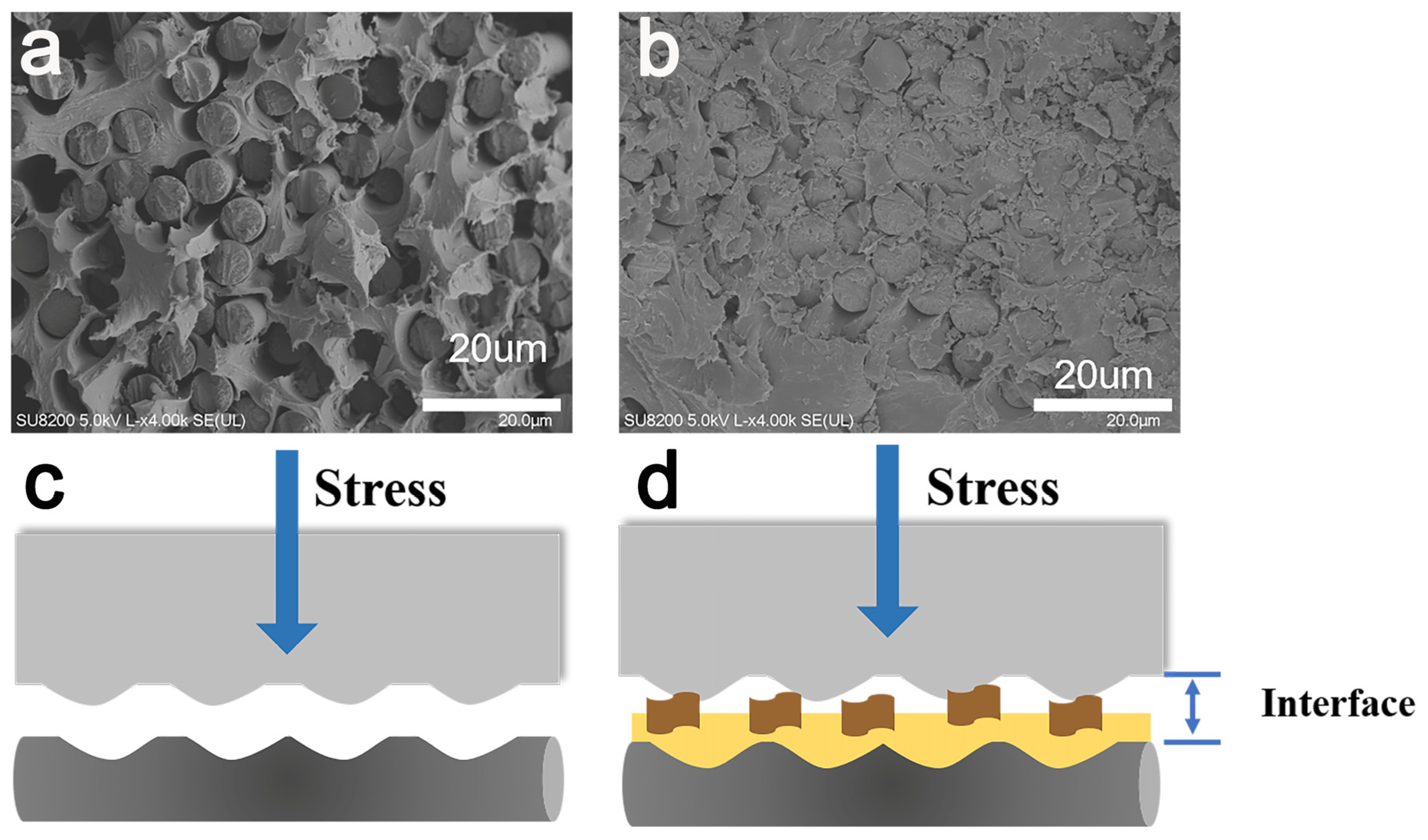
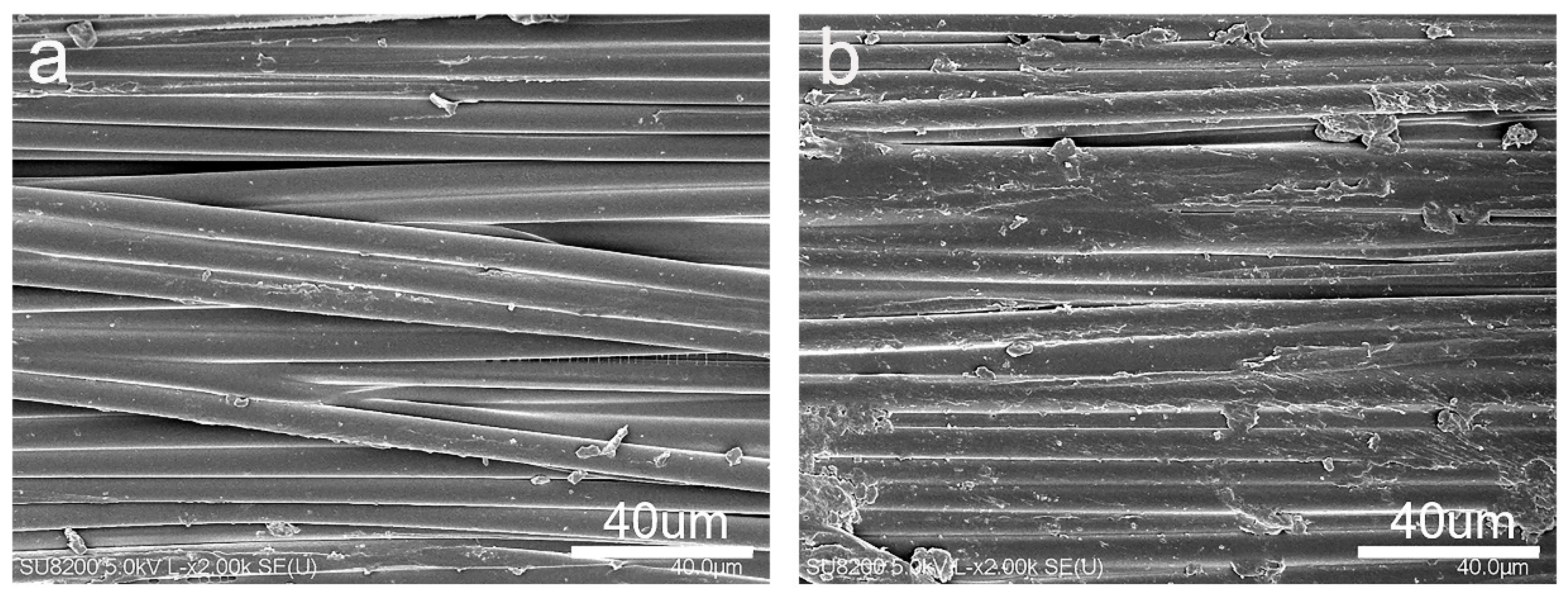
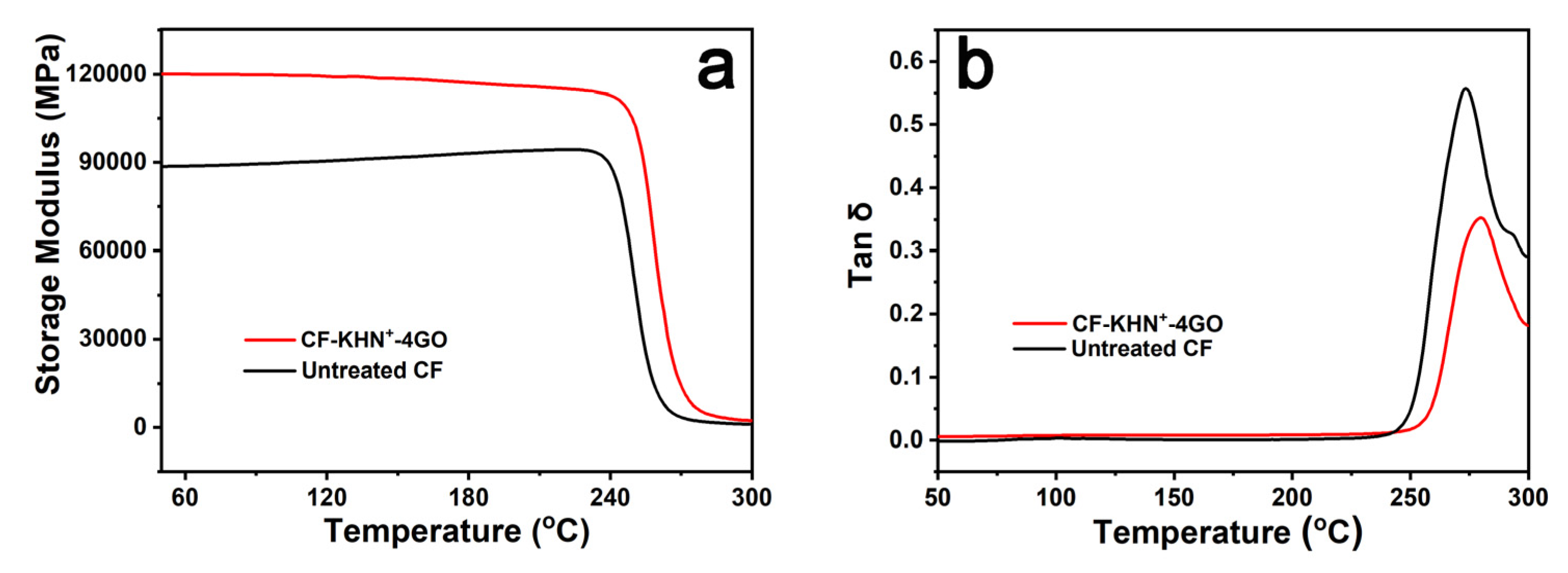
| D | G | A | ||
|---|---|---|---|---|
| Samples | W (cm−1) | W (cm−1) | W (cm−1) | R = AD/AG |
| Untreated CF | 1359 | 1596 | 1512 | 2.29 |
| CF-KNH+ | 1363 | 1601 | 1525 | 2.70 |
| CF-KNH+-4GO | 1364 | 1602 | 1529 | 3.38 |
| Contact Angle θ (°) | γd (mN/m) | γp (mN/m) | γ (mN/m) | ||
|---|---|---|---|---|---|
| Water | Diiodomethane | ||||
| Untreated CF | 69.8 | 56.3 | 30.70 | 10.46 | 41.16 |
| CF-KNH+ | 65.4 | 52.1 | 33.10 | 11.95 | 45.05 |
| CF-KNH+-2GO | 61.7 | 44.9 | 37.06 | 12.4 | 49.46 |
| CF-KNH+-4GO | 50.2 | 34.7 | 42.17 | 16.92 | 59.09 |
| CF-KNH+-6GO | 50.6 | 35.8 | 41.66 | 16.83 | 57.22 |
Publisher’s Note: MDPI stays neutral with regard to jurisdictional claims in published maps and institutional affiliations. |
© 2021 by the authors. Licensee MDPI, Basel, Switzerland. This article is an open access article distributed under the terms and conditions of the Creative Commons Attribution (CC BY) license (https://creativecommons.org/licenses/by/4.0/).
Share and Cite
Cheng, S.; Li, N.; Pan, Y.; Wang, B.; Hao, H.; Hu, F.; Liu, C.; Chen, Y.; Jian, X. Establishment of Silane/GO Multistage Hybrid Interface Layer to Improve Interfacial and Mechanical Properties of Carbon Fiber Reinforced Poly (phthalazinone ether ketone) Thermoplastic Composites. Materials 2022, 15, 206. https://doi.org/10.3390/ma15010206
Cheng S, Li N, Pan Y, Wang B, Hao H, Hu F, Liu C, Chen Y, Jian X. Establishment of Silane/GO Multistage Hybrid Interface Layer to Improve Interfacial and Mechanical Properties of Carbon Fiber Reinforced Poly (phthalazinone ether ketone) Thermoplastic Composites. Materials. 2022; 15(1):206. https://doi.org/10.3390/ma15010206
Chicago/Turabian StyleCheng, Shan, Nan Li, Yuxi Pan, Bing Wang, Haoyue Hao, Fangyuan Hu, Cheng Liu, Yousi Chen, and Xigao Jian. 2022. "Establishment of Silane/GO Multistage Hybrid Interface Layer to Improve Interfacial and Mechanical Properties of Carbon Fiber Reinforced Poly (phthalazinone ether ketone) Thermoplastic Composites" Materials 15, no. 1: 206. https://doi.org/10.3390/ma15010206






